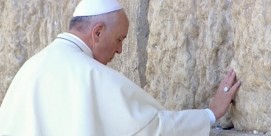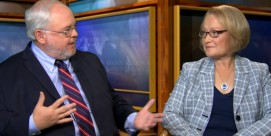In This Episode << SLIDE LEFT TO SEE ADDITIONAL SEGMENTS
Father Thomas Joseph White Extended Interview
Read more of the interview about Flannery O’Connor with Father Thomas Joseph White, O.P., a Dominican priest and instructor in theology at the Dominican House of Studies in Washington, DC:
I myself am from Georgia and had never discovered Flannery O’Connor while living in the South, but while I was in a boarding school in Massachusetts at age 16 had works of Flannery O’Connor assigned to me in English class and read her for the first time, and shortly thereafter a friend of mine gave me her letters as a Christmas gift, and I read those somewhat assiduously and became very interested in her person, in her stories.
Reading Flannery O’Connor for the first time did change my life a little bit. I mean it was the first time I had read a Christian thinker, or a Christian writer who I thought was impressive intellectually and challenging. I was a secular person, and her worldview was so different, so abrasive in some ways, very jarring.
I found it offensive and fascinating and problematic and attractive, and so I acquired a sort of new sensitivity to Catholic thought. It was the first time I read a Catholic intellectual, and then I started reading some of the people she wrote about in her letters, the works she was reading of philosophy or theology, and discovered from that something about the Catholic intellectual tradition, and that led me to actually become a Christian. My mother’s from a Protestant background, so I initially sought baptism as a Protestant and then remained interested in Catholicism partly through [O’Connor’s] influence and then kept reading authors in that tradition, and eventually, within about three years, became a Roman Catholic.
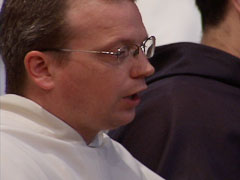 Father Thomas Joseph White, O.P. |
I can’t say that Flannery O’Connor’s writings directly influenced my decision to become a Catholic priest. I think that came from a higher source and intervention. But I think she was the first person I ever read who gave me the impression that Thomas Aquinas’s thought would be maybe quite important, and I joined the Dominican order eventually, which is an order that Thomas Aquinas was a member of, and where his thinking is very prevalent, so she gave me a first initial sympathy to his thought.
Many of her characters are people struggling with the question of whether there’s any meaning in the world at all or any meaning in life, and she has a great capacity to at the same time in a certain way project what that personality is—the searcher, or the person who questions meaning, and she also satirizes that person, sometimes brutally, and it’s both showing the pain of the person in disbelief or with lack of religious orientation and at the same time making fun of them. That is so provocative and almost painful, and I think it gave me the impression that someone could both understand me or understand something about me and also challenge me very deeply in my conception of the world religiously. I think that understanding of modern unbelief, and at the same time that kind of almost robust satire of modern unbelief was very provocative to me. It gave me the impression she had some perspective that would be interesting to chase down.
Flannery O’Connor’s said “people who read my works tend to think I’m a hillbilly nihilist, but I would like to be seen rather as a hillbilly Thomist,” and one of the things I think she’s clearly taken from St. Thomas is this understanding of what a sacrament is. In the Catholic tradition there are seven sacraments, and a sacrament is both a sign and an instrument of grace, so that it symbolizes what it also confides, that is to say the grace of God. She says very clearly in a number of places her stories are about how God’s grace works invisibly in the world for people who don’t have sacraments. So she’s trying to write as a kind of hillbilly Thomist about how God works in a non-Catholic terrain of southern Protestantism, of skeptical southern progressivists etc., and in that context looking at how kind of grace manifests itself in signs that are instruments, but you don’t have baptism, confession, and the Mass, which she says are the center of her life. You have instead odd and grotesque, historically surprising events where people encounter the grace of God. Someone throws the book across the room at someone they’re angry at, and the book is called “Human Development,” and when it smacks the person on the head you have the confiding of grace. The book is a sign and instrument of human development, and the absolute becomes manifest in this very concrete, sacramental way. In her story “Greenleaf” you have Miss May who’s gored to death by a bull, who represents Christ, and as the horn of the bull pierces her heart she looks up to heaven, and the bull is a sort of sacramental presence of grace. That’s very odd, it’s very provocative. It’s Catholic but with a very strange twist. The second thing I’d say about sacraments for Aquinas is they’re only suggestive of a glory to come. They’re not a full realization of what we will see in heaven, and so there’s a lot in Flannery O’Connor about a partial, almost secret unveiling of God in the world, leaving the reader with questions and leading the reader toward more questioning about God. So there’s a sort of mysterious ambivalence. If God’s at work in the world, we don’t find him very easily. His grace can explode onto the world, but it also leads us to a higher aspiration to see God, to know God beyond this world. That’s very Catholic. She talks about how she wants to stimulate an understanding of God’s grace hidden in the American South.
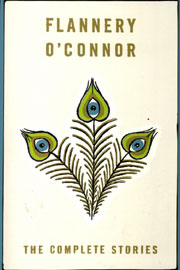 I think she’s trying to both teach and shock. Teach and shock are not opposed for her. She says that in a very secular world that we have trouble recognizing the sacred except under the signs of violence. But it’s not a violence that is from the outside. I mean she’s clear about that. The violence of the external, physical events that are shocking is meant to reflect an inner violence of the conversion of love, and she says this when she talks about the title of her book The Violent Bear it Away. She says St. Thomas says the violence that bears us away to Christ is the violence of love that allows us to overcome the defects of our own nature that’s fallen and that’s fragile and can be selfish and egoist. So it’s about the violence of love converting itself to God. The shocking violence of the exterior world is supposed to mirror the internal conversion of love. It’s not something that’s opposed to the will or destroying our freedom. It’s something opening our freedom. She’s very clear about that. Her stories are humorous because her stories are about liberation, but it’s often a liberation that comes despite our selves. We don’t want to be free. We actually want to be free from the love of God, and the love of God comes in kind of comic ways, almost violently frees us to be our better selves.
I think she’s trying to both teach and shock. Teach and shock are not opposed for her. She says that in a very secular world that we have trouble recognizing the sacred except under the signs of violence. But it’s not a violence that is from the outside. I mean she’s clear about that. The violence of the external, physical events that are shocking is meant to reflect an inner violence of the conversion of love, and she says this when she talks about the title of her book The Violent Bear it Away. She says St. Thomas says the violence that bears us away to Christ is the violence of love that allows us to overcome the defects of our own nature that’s fallen and that’s fragile and can be selfish and egoist. So it’s about the violence of love converting itself to God. The shocking violence of the exterior world is supposed to mirror the internal conversion of love. It’s not something that’s opposed to the will or destroying our freedom. It’s something opening our freedom. She’s very clear about that. Her stories are humorous because her stories are about liberation, but it’s often a liberation that comes despite our selves. We don’t want to be free. We actually want to be free from the love of God, and the love of God comes in kind of comic ways, almost violently frees us to be our better selves.
Flannery O’Connor was a very intuitive, I would almost say shoot-from-the-hip kind of Catholic. She had a deep intuitive sense of the truth in Catholic faith.
She says in one of her letters I am a Catholic not in the way some people are Baptists or Methodists, but in the way some people are atheists. It has a kind of evidential force for me that I find difficult to question’, not in the sense that she was an anti-intellectual. If anything she read avidly, lots of secular as well as religious authors and theologians. But there’s a sense in which she’s grounded in something prior to speculations or deductions or arguments. She’s got a deep intuitive sense of Christ present in the Mass. She says Mass is the stable pillar of her life, that it’s what makes life in the modern world tolerable for her. So she’s a fairly traditional Catholic, I think.
Flannery O’Connor says repeatedly in her letters to Betty Hester that dogma is not a force that’s anti-intellectual for a believing Catholic, nor does it cramp one’s freedom, but rather dogma preserves and safeguards mysteries that open the mind to contemplation and preserve the freedom of the person to approach God more intimately. So she sees dogma not as something anti-intellectual or hampering the development of the human person, but opening the human person up to the mystery of God. She was very concerned about the Catholic Church’s moral teachings in the sense that she was very committed to them. She knew in her own day about the controversy about the question of regulation of birth and birth control, and she was pretty clear that she was on the side of the church’s traditional teaching. She said we should be prepared to move over and get used to being crowded rather than anybody commit the least sin with regard to the Church’s teachings in this domain, so I don’t know how she would have reacted to the liturgical changes of Vatican II, but I think in terms of the teaching of the Catholic Church concerning doctrine and morals, she had a very deep reverence for the church’s tradition.
She says a southern writer is challenged to write as a Catholic because you’re writing in a Protestant culture. It’s not a Catholic culture, and so you’re showing how certain truths that Catholics may have even become numb to about their own faith can be discovered under grotesque or ironic forms by Protestants. She tells a story about this where she mentions a real event in the ’50s of a Tennessee revivalist minister who for his Lenten revival tied a living lamb by a chain to a cross for his congregation and then sacrificed it there in front of the congregation. She said, well, he may have been doing that for show, but I think that’s just as close to the Mass as he can get, and she says what he is doing there represents, in a certain ironic way, under forms that Catholics might not even recognize easily, a truth they’re living day to day in Mass. But she says if I wrote things that I think are truly grotesque, like if I wrote about people with totally meaningless lives, it might be considered normal in the north—she says that—but when I write about anything southern it would be considered grotesque in the north. She says in the south, because it’s Christ-haunted, you find, at least in her day and age she could say that, because it’s Christ haunted it’s not Christ-centered, you find she says a disfigured image of Christ in people’s suffering and in their brokenness, even if it’s disfigured and broken it’s better than no Christ at all. In the end of the story “A Good Man is Hard to Find,” when The Misfit kills the grandmother, and the blood of the grandmother is on his eyes, on his glasses, and he cleanses them, her death—he kills her because she’s compassionate to him. She’s compassionate to him because she sees he agonizes over the person of Christ, and there’s a moment in which grace touches her and saves her but also invites him to salvation, and his eyes are open for a moment by her blood, and he says she would have been a good woman if there had just been someone there to kill her every day of her life. And I think what Flannery O’Connor is saying in part is the Catholic life of expiation and suffering for others is what also makes us good people. We don’t have, as Catholics, someone there to shoot us every day of our life. What we have every day is the Catholic Mass. We die with Christ in the Mass, we live with him, and she says the suffering of human beings everywhere is in some way an initial participation of that mystery, an anticipation of redemption in Christ. So she’s looking at Southerners in the imperfections of their faith, their deep human imperfections, and she’s seeing how Christ is sort of hidden in them in ways that foreshadow or speak of Catholic realities, of God uniting us in our suffering to the mystery of the cross, so I think that there’s something like that going on.
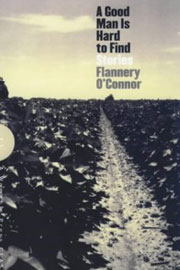 Thomas Merton is a person whose whole life is characterized by movement, and even up until the end of his life he’s really trying to figure out what he believes in a certain way, and there’s a dynamic there that fascinated his generation, because it’s somebody really trying to find the truth whose a nonbeliever, who becomes open to Catholicism, who converts, who writes eloquently about his conversion, but he was restless, whereas with Flannery O’Connor you get the impression of somebody who accepted herself as a Catholic and as a person who’s Southern and as a person from the rural South, as a person who is sick and had to go home physically ill and live with her mother and be cared for until death. There’s a certain solidity to her, a bemusing certitude. But also, I think, more than Merton she’s fascinated by speaking with unbelievers. I think Merton is trying to articulate his experience of faith for his generation, how to believe in the world today. I think she’s much more interested in communicating traditional Catholic truths to people who are radically separated from the Christian tradition.
Thomas Merton is a person whose whole life is characterized by movement, and even up until the end of his life he’s really trying to figure out what he believes in a certain way, and there’s a dynamic there that fascinated his generation, because it’s somebody really trying to find the truth whose a nonbeliever, who becomes open to Catholicism, who converts, who writes eloquently about his conversion, but he was restless, whereas with Flannery O’Connor you get the impression of somebody who accepted herself as a Catholic and as a person who’s Southern and as a person from the rural South, as a person who is sick and had to go home physically ill and live with her mother and be cared for until death. There’s a certain solidity to her, a bemusing certitude. But also, I think, more than Merton she’s fascinated by speaking with unbelievers. I think Merton is trying to articulate his experience of faith for his generation, how to believe in the world today. I think she’s much more interested in communicating traditional Catholic truths to people who are radically separated from the Christian tradition.
Sophocles points out the tragedies in life and the monstrous dimensions of human existence, and Flannery O’Connor doesn’t have a tragic worldview, but there’s a tragic moment in her stories. She’s very Augustinian. She says the truth of the doctrine of original sin is at the base of all my stories, and also the truth of redemption. So where she’s very different from a lot of our contemporary sensibilities is she thinks it’s both necessary, but also somewhat humorous, to see our fragilities and our weaknesses and our brokenness. She’s very interested in showing human brokenness and even our ugliness, not as an end in itself, I mean that’s where it is the tragic dimension, and almost the grotesque dimension, but it’s ultimately comic for her, because once you admit your brokenness, or you can admit your brokenness if you see the flip side of it, which is the mystery of redemption and grace, and the fact that God in the end is compassionate. So the way grace breaks in and makes use of our disillusionment with ourselves, the tragic conundrums we’re in, is almost playful. It’s almost a violent playfulness, but there’s a sort of gravity of love that comes into characters’ lives, disillusions them, shows them the tragic component of their life, shows them their brokenness, but also only ever does that to introduce them into something higher, which is God’s love and mercy, and there’s something comic about it in the way she writes about it.
I think the most important thing for contemporary Catholics about Flannery O’Connor’s work is that she has the mindset of a person who’s expecting to be misunderstood in contemporary culture. She’s writing provocatively, elliptically, suggestively about what she treasures most or believes in most deeply, the mystery of Christ, mystery of grace, but in a world where she expects to be misunderstood, perhaps resented, even despised, and that tension that animates her work is very suggestive for modern Catholics who increasingly understand themselves to be in a very secular surrounding society that doesn’t necessarily understand their viewpoints. So she’s trying to talk to people who are even hostile or very different in mindset. She has a very strong consciousness that she’s speaking to and with people who find Catholicism alien or strange, and she’s attempting to convey truths of the Catholic faith in elliptical or suggestive or inviting ways, provocative ways, but she wants to defy immediate expectations and instead move on to more substantive conversation, and she’s found a way to do that through a literary format, and I think that’s one of the great challenges for Catholics in an increasingly secular world is how do you talk about your faith when it’s likely to be perceived as alienating to people in ways that move beyond the initial constraints of provocation and into a deeper, substantive discussion, and Flannery O’Connor’s figured out a way to do that in a literary motif.
She is an artistic genius, so just on a natural level her work has an incredible originality to it, and she can embody something of the genius of her culture, so to speak, in a very raw, almost primitive way. She has this deep absolutism, this deep, concrete way of writing. She’s mastered the Southern dialect, so there’s something just as a literary art form very original and very inviting, and a lot of the people who originally read it were not particularly interested in the religious ideas, the religious content, and I think as time goes by, as people read more of her letters and see what the whole corpus of her writing is about, it becomes more evident that you have to have a theological level of reading to see her deepest aspirations. She is very explicit about that herself, and I suppose also because she says really, basically in her letters, the two choices in the modern world, she says that it’s—in rural Georgia 1955 the two choices in the modern world are really between nihilism or Roman Catholicism, and that’s a very odd viewpoint in Protestant, if I may say, Biblicist, southeastern culture in America in 1955 but that doesn’t seem like such a strange juxtaposition to us 50 years later. She talks about the advent of an age of nihilism, and I think she means by that an age in which all values seem relative and a matter of subjective preference, and it’s impossible to discern if there’s any transcendent meaning in life. She says that leaves you a humanity like certain chickens where they bred off the wings, made them smaller to get more white meat, so humanity becomes a bunch of wingless chickens. She says, “I think that’s what Nietzsche meant when he said God is dead.” In the absence of a value system in a relativistic world, people become just kind of non-vital. They lose their vitality, and she’s offering up a vision of a deep Catholic vitality based on grace, based on a sacramental view of the world.
 Martin Heidegger |
I think we’re living in a time when there’s an increased de-Christianization or secularization of contemporary culture, and what happens in that sociologically is that a majority of people who were previously educated in the Protestant or the Catholic tradition tend to gravitate toward a more secularized stance of interpretation of the world, so that to be a Christian in contemporary Europe or America tends to make you more of an anomaly. That being the case, the people who actually persevere or tend to continue to want to be religious tend to have a countercultural identity, and you see that more in evangelical movements and in the Roman Catholic movement in America. So young people today who are devout Roman Catholics tend to expect to be misunderstood, maybe even disagreed with frequently, so at the same time their interest in recovering their tradition, also because they feel like it’s under threat, the identity of the very church and her tradition is perceived as being subject to perhaps ceasing to be.
There’s no question we live in a more secularized America than in the age of Flannery O’Connor. I don’t know what her influence will continue to be, but I think the fact that she understands her writing to be geared towards a very secularized world, or that the real choice in her writing is between a robust Catholic identity or capitulation to a very secularized world, I think that tension or juxtaposition is something she lived very personally in her own decision to be a believer. I think that she continues to speak to people who are confronting that decision. She read Nietzsche, she read Sartre, she read Heidegger. And Hulga or Joy, in the story “Good Country People,” is a person who moves from a cynical, dark view of reality based on her own very superficial understanding of Heidegger, pseudo-intellectual, really. Flannery O’Connor’s making fun of herself and moves to this shocking conversion of realizing her need for grace in the end of the story, at least we can suppose, I think, and she really represents Flannery O’Connor herself who walked on crutches while she was writing the story, who doesn’t have a leg to stand on, so to speak, if you put her in terms of Joy or Hulga, and who discovered her need for grace, that she can’t just live by her own powers, and has moved from a secular worldview to a religious worldview. I think that the juxtaposition in Flannery O’Connor’s life itself between the decision to practice her Catholic faith versus her encounter with secular thinkers like Nietzsche and Joyce and Heidegger, that juxtaposition continues to be one that is very visceral for a lot of Americans, or a lot of modern people, that her writing speaks to—the decision between a radical unbelief, which is in her character Hazel Motes before his conversion versus radical discipleship in a very secular world, which is Hazel Motes after he’s converted and puts his eyes out and converts to God in a really radical way. She, of course, sees him as a saint. He’s a nihilist before, he’s a saint afterwards, and that is an interesting commentary on options that a lot of people would consider still viable options, to pursue a life of God or to pursue a life without God. So she’s really trying to put the choice in front of us.



